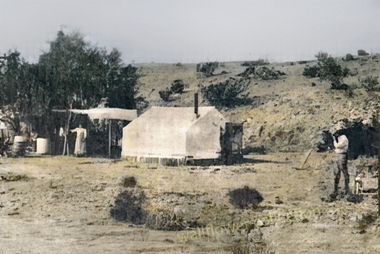Southeast San Bernardino County:
Savahia Peak Area
West of Copper Basin, probably one of the first mines to be developed was the American Eagle. A somewhat confusing account in 1905 linked McGuire to the discovery of the claims, perhaps as early as 1875. At that time a large quantity of high grade gold and copper ore was shipped to Swansea, Wales. In 1902, five men were employed at the mine, and by 1905, the American Eagle boasted a 110 foot deep shaft with 200 feet of additional underground workings. In 1908, they were completing arrangements to begin work again, and it appears they did, sinking the shaft to 300 feet and making a small shipment, with which they failed to break even. In 1912, the property was leased to James S. Douglas, and it was last operated in the winter of 1918-1919. 57The town of Vidal was founded as a trading post in 1907, and soon after, Wyatt Earp, the famous lawman, and his wife settled there. He had a small mine in the Whipples on which the deepest shaft on the property was 100 feet. Earp operated his mine intermittently until he died in 1929 at the age of 80. In 1971, his house still stood in the shifting sands and tumbleweeds east of the highway. 58
Other mines worthy of mention in the vicinity are the Tuscarora, the Savahia, and the D&W. The D&W, named after the locators Dayton and Wilbur, was by far the biggest. The D&W was incorporated in 1906 and work then began in earnest. The main shaft probably reached about 300 feet during 1907. In November, 1909, good ore was showing up at considerable depth, and by 1911, the shaft had reached 700 feet. While cutting a drift on the 700 foot level, a vein of free milling gold ore, running $10 to $14 a ton was discovered. Additional work on the other levels also discovered this vein. Up to that point, work had concentrated on a vein carrying mostly copper values. In October, two shifts were at work, after being closed down from June to September because of the heat. 59
There was some talk of installing a mill as early as January, 1912, and after a busy season of mining, when the mine closed for the summer of 1912 the D&W Company felt enough ore had been developed to warrant a mill. Water was to be obtained from the third level of the mine. 60
Grading began that November for the mill, which was to arrive in Vidal most any day, but in January of 1913 the machinery for the mill still had not arrived. That did not dampen spirits much, as plans were announced for a real celebration party when the mill began on March 1, 1913. Two Pullman coaches were to be run from Los Angeles with the stockholders and friends, an estimated 200 people. This bash was going to last two days and everyone is assured the time of their lives. There will be plenty to eat, and plenty to drink... Besides a barbecue, there will be dancing. March came and went, and it was not until November 6, 1913, that the mill began operation. While three shifts worked for awhile, the operation soon slowed. The mill was idle from the beginning of 1914 until April, 1916, when work resumed on a small scale. 61
Earp Cabin
Vidal, California
Savahia Peak Rock Collecting
The large wash north of U.S. Highway 62 just 2 miles east of Vidal Junction is an excellent site for collecting chalcedony, which can be found from Highway 95 extending east approximately 1 mile. The best method of working a site is to park safely off the pavement and walk east through the wash. The bright white chalcedony is easy to spot against the darker soil. (BLM)Highway 62
Highway 95

Wyatt Earp's Happy Day mine